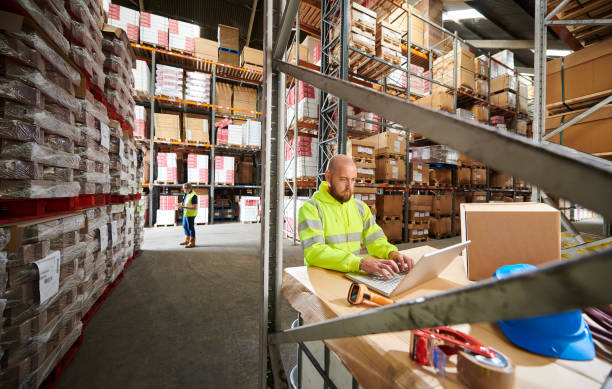
Online retail has changed the face of logistics because warehouses are now high-speed fulfillment centers that operate to satisfy the demands of e-commerce. Automation, high work turnover, and high worker density are putting an unprecedented cooling burden on these modern facilities. Contrary to inert storage spaces, fulfillment centers need dynamic climate conditions in order to be efficient and comfortable. The higher automation, faster turnover, and increased worker density in e-commerce fulfillment centers make industrial cooling solutions, particularly the HVLS types, necessary to support modern-day logistics. Increasing worker productivity, cooling e-commerce fulfillment centers with better cooling, and lowering HVAC costs by 20-30 percent, HVLS fans can meet these changing requirements. Let us see the transformation of warehouse operation, new cooling troubles, the solution of new cooling troubles by new warehouse ceiling fans logistics, comparison, ROI and future of industrial fans fulfillment warehouses.

The Changing Nature of Warehouses
E-commerce has caused a seismic shift in the logistics industry, and by 2025, online retail worldwide is expected to be worth 7 trillion dollars. The development has changed how warehouse works and its cooling needs.
Traditional Warehouses: Static Storage
Conventional warehouses were geared towards long-term storage, where there is little movement and fewer people are present. Their pallets were stored in large, open places (50,000-200,000 square feet) and with high ceilings (20-40 feet), and they needed to be ventilated with basic facilities to avoid heat accumulation. Freezing was usually an afterthought, with inventory a slow turnover and automation sparse.
Fulfillment Centers: Dynamic and Fast-Paced
E-commerce fulfillment centres are centres of constant action as they process orders fast to be delivered either on the same day or next day. They have a greater worker density (1-2 workers per 1,000 square feet compared to 0.5 in conventional warehouses) and a wide range of automation (conveyors, robotic pickers, and packaging machines that produce lots of heat). This leaves the need of modern warehouse ventilation solutions to ensure the best conditions are kept.
Heat from Equipment
Robotic arms and conveyor belts, which are part of automation equipment, produce heat loads of 5-10 kW per system to increase the indoor temperature by 5-10 degrees F. This, together with regular door openings during shipping, increases cooling loads, and, therefore, cooling automation of warehouses becomes the priority.

New Cooling Challenges in Fulfillment Centers
The intensity of operations poses both a challenge to fulfillment centers that traditional warehouses seldom face.
Heat Buildup from 24/7 Operations
Fulfillment centers, unlike the more traditional warehouses, are 24-hour operations that are intended to satisfy the needs of e-commerce. Workers, robots, and machinery are constantly on the move, creating high temperatures, (above 85 F in summer). According to OSHA, those conditions augment the hazard of heat stress, cutting productivity by 2 percentages per degree more than 77 F (25C).
Worker Comfort in Dense Zones
Workers are densely packed in packing and shipping areas where they do monotonous jobs. Heat stress leads to fatigue which doubles the rate of error by 15-20% and absenteeism by 10%. Ineveness in cooling generates hot spots around the docks or cold spots in stockings, interfering with comfort cooling of the workers in the warehouse.

Protecting Sensitive Goods
E-commerce centers deal with electronics, perishables and pharmaceuticals and can have stable temperatures (60-80F) and a humidity of less than 60%. Substandard cooling can lead to spoilage or damage and result in thousands in losses. Good fulfillment center HVAC integration plays a key role in securing inventory.
How Ceiling Fans Address These Needs
The 8-24 feet diameter HVLS ceiling fans circulate up to 400,000 cubic feet per minute, which has been shown to be the perfect solution to the challenge of fulfillment centers.
Large-Scale Air Movement and Destratification
HVLS fans mix up air, hot air at the ceiling, with cold air at the floor and even out temperature differences by 5-10. This removes hotspots in busy areas, which helps to meet changing cooling requirements in e-commerce warehouses. One fan serves 10,000-22,000 square feet, which is best suited to a large fulfillment center.

Reduced Reliance on Costly HVAC
HVLS fans reduce HVAC energy consumption by 20-30 percent by permitting warmer thermostat settings (3-5F, which saves 4 percent per degree) and recycling the warm air in winter. They are cheap to install as a component of ceiling fans because of their low power consumption (less than 1.5 kW) compared to the HVAC 50- 200 kW.
Even Airflow Across Zones
Fans are used to maintain a steady air flow through receiving, picking, packing and shipping areas. Variable speed controls respond to activity, delivering focused cooling to where it is required. A 150,000-square-foot center had reduced heat complaints by 20 percent following the installation of six HVLS fans.
Comparison: Traditional Warehouses vs. Fulfillment Centers
Conventional warehouses require less cooling because of the non-dynamic operations and reduced number of workers. Simple HVAC, or small fans are adequate since stratification is not as important in less active spaces. With its 24/7 operation and automation, fulfillment centers experience increased heat loads and demand HVLS fans to achieve airflow on an extensive scale. Conventional systems could require 10-20 smaller fans, and one HVLS fan can replace several, saving money and complexity.
ROI and Operational Benefits

Energy Savings and Lower Operating Costs
In a 100,000-square-foot fulfillment center, the HVLS fans would save 10,000-50,000 in energy per year and cost 20,000-60,000 to install (4-6 fans). Return on investment is 12-24 months, according to industry standards. The cost of maintenance is low (200-500/yr), versus the 5,000-20,000 of HVAC.
Reduced Absenteeism and Improved Efficiency
HVLS fans can cut the rate of heat-related absences by 10-15% and mistakes by 15% and increase production. Case study: an 200,000-square -foot facility equipped with eight HVLS fans reduced absenteeism by a quarter of the amount, and boosted picking accuracy by a fifth, which saved the facility 75,000 per year in labor expenses.
Supporting Green Logistics Goals
The fans comply with LEED and ISO 50001 and ensure the minimization of emissions (20-30% with energy consumption). This helps to achieve e-commerce sustainability, which improves brand reputation.

Future Outlook: Integration with Smart Systems
IoT integration is the future of contemporary warehouse ventilation solutions. HVLS smart sensor-equipped fans can be customized to respond to the needs of real-time heat or occupancy data to optimize the fulfillment center HVAC integration. With the rise of e-commerce (8% CAGR by 2030), hybrid cooling systems that use both fans and HVAC will become the norm, and will save on automated warehouse costs.
FAQ: Common Questions About Ceiling Fans in Fulfillment Centers
- Do fulfillment centers need more cooling than warehouses?
Yes, online 24/7 operations and automation produce more heat, and cooling must be installed in the e-commerce fulfillment center such as HVLS fans. - Can ceiling fans handle 24/7 operations?
Indeed, industrial fans fulfillment warehouses are designed to be used continuously with designs that can last up to 15-20 years. - How do HVLS fans improve worker comfort and equipment protection?
They lower to 5-10 C heat load and humidity, facilitated by them, the warehouse cooling of workers and the preservation of fragile products.
Conclusion
This is because automation, high employee density and a high worker turnover present unique cooling issues to e-commerce fulfillment centers that require sophisticated solutions. Logistics of warehouse ceiling fans, especially HVLS addressing it on a large scale, have been having vast airflow, saving energy and increasing productivity. Operators in e-commerce are supposed to implement industrial ceiling fans in order to satisfy logistics requirements. RTFANS is the provider of configured HVLS fans e-commerce solutions with 20+ years of experience. Call us today to maximize your cooling in your center- your operations are worth it.
